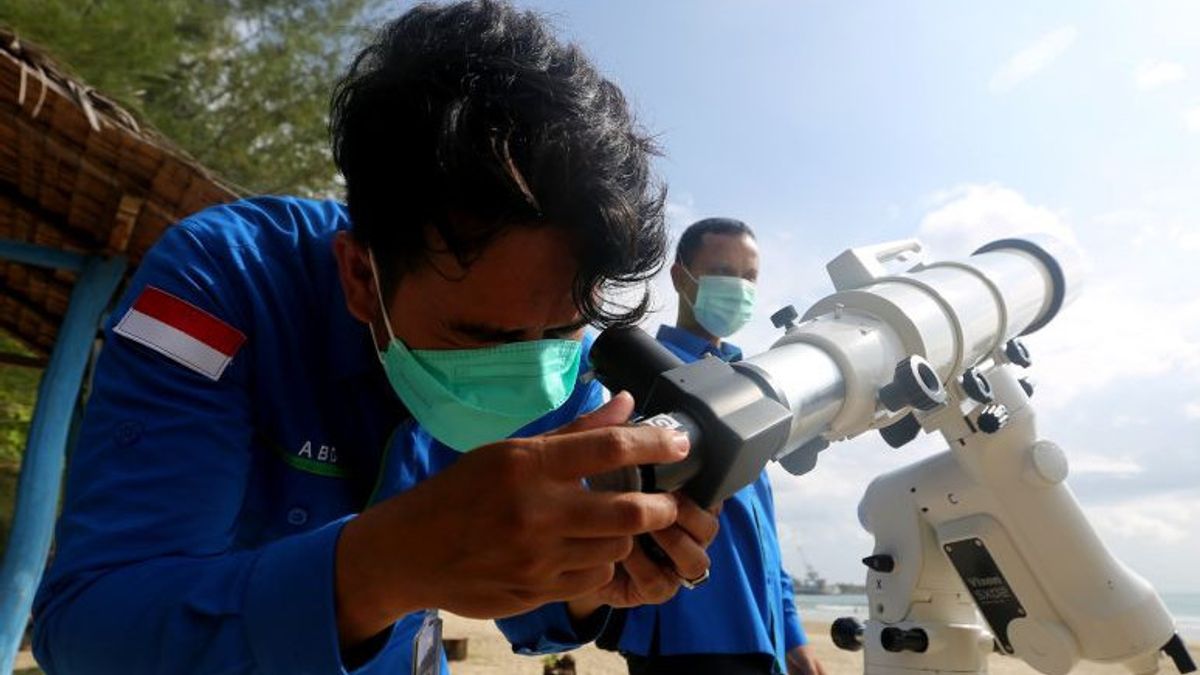JAKARTA - The government through the Ministry of Religion will hold an isbat session to determine the beginning of Ramadan on Friday, April 1 this afternoon. The isbat trial was conducted after receiving reports from hilal monitors spread over 101 points from Sabang to Merauke.
Later, Indonesian Muslims will know when the 1st Ramadan falls, whether it falls on Saturday or Sunday. However, the Muhammadiyah Central Leadership has determined 1 Ramadan long ago.
Muhammadiyah, which uses the actual reckoning method, forms of the hilal, considers that on Friday, April 1, 2022 AD, the ijtima before Ramadan 1443 H occurred at 13:27:13 WIB.
The height of the Moon at sunset in Yogyakarta (f = -07° 48¢ South Latitude and l = 110° 21¢ East Longitude ) = +02° 18¢ 12² (the new moon is already in existence), and in all parts of Indonesia at sunset the Moon is above the horizon. Thus, Muhammadiyah has determined that 1 Ramadan 1443H will fall on Saturday, April 2, 2022.
Meanwhile, Nahdlatul Ulama (NU) which uses the rukyatul hilal method assesses that the position of the hilal on Friday is slightly above the imkanur rukyah criteria (the possibility of the hilal being visible).
The PBNU Falakiyah Institute's reckoning data shows that the new moon is already above the horizon, to be exact +2 degrees 04 minutes 12 seconds and the new moon is 9 minutes 49 seconds monitored at the PBNU Jakarta Office, coordinates 6º 11' 25” South Latitude 106º 50' 50” east longitude. While the conjunction or lunar ijtima will occur on Friday, April 1, 2021, at 13:25:54 WIB.
The location of the sunset is at a position of 4 degrees 34 minutes 09 seconds north of the west point, while the location of the new moon is at a position of 2 degrees 48 minutes 22 minutes north of the west point. The position of the new moon is at 1 degree 45 minutes 47 seconds south of the sun in a state of tilt to the south with an elongation of 3 degrees 24 minutes 06 seconds.
For NU with an altitude of 2 degrees over 4 minutes and 3 degrees 4 minutes, the hilal seems to be difficult to rukyat. Moreover, the age of the moon that has not reached 8 hours. If the new moon is not seen, the month of Shaban will automatically be fulfilled to 30 days. That way, the beginning of Ramadan 1443H could fall on Sunday, April 3, 2022. Meanwhile, Saturday, April 2, 2022, it will still be on the 30th of Shaban 1443 H.
Meanwhile, the Ministry of Religion this year began to use new criteria for determining the beginning of the Hijri month. The criteria refer to the agreement between the Ministers of Brunei Darussalam, Indonesia, Malaysia and Singapore (MABIMS) in 2021.
So far, the criteria for the initial Hijri hilal (month) guided by the Ministry of Religion are a height of 2 degrees, an elongation of 3 degrees, and an age of 8 hours. MABIMS agreed to change the criteria to a hilal height of 3 degrees and an elongation of 6.4 degrees.
But what exactly is the method of Hisab Hakiki Wujudul Hilal, Rukyatul Hilal, and the MABIMS agreement?
MethodHisab Wujudul Hilal method is a method that calculates the position of the moon astronomically. The lunar month only begins if on the 29th day running at sunset three conditions are met; ijtima has occurred, ijtima occurs before sunset, at sunset the Moon (top disk) is still above the horizon.
Making the presence of the moon above the horizon at sunset as a criterion for the start of a new moon is an abstraction of the rukyat commands and the fulfillment of the thirty-day month when the new moon is not seen.
Just like imkan rukyat, the form of the hilal method is also part of the true reckoning. The difference is, embodiment of the new moon provides more certainty than reckoning imkan rukyat. If the position of the moon is already above the horizon at sunset, no matter how high it is (even if it's only 0.1 degrees), then tomorrow is the first day of the new moon.
Rukyatul Hilal is an activity to observe the visibility of the new moon at sunset on the 29th of the lunar month. In other words, rukyat is only performed when the sun-moon conjunction has occurred and at sunset, the new moon is above the horizon and is in a visible position.
If on that date the new moon is not visible, whether due to weather factors or indeed the new moon has not been seen, then the lunar month is fulfilled so that it is 30 days. This method is usually done before the big Muslim holidays such as the beginning of Ramadan, Shawwal, and Zulhijah. This method cannot predict the date far in advance, because the new date can be known on d-1 or day 29.
However, for MUI, the two methods are actually one unit, because both reckoning and rukyat confirm each other in determining the beginning of the Hijri month.
The results of astronomical calculations or reckoning are used as initial information which is then confirmed through the rukyat method (monitoring in the field).
Meanwhile, the MABIMS criteria are the results of the Muzakarah Rukyah and Islamic Takwim MABIMS in 2016 in Malaysia. This criterion was strengthened by the Falak Fiqh International Seminar in Jakarta which resulted in the Jakarta Recommendation in 2017 and was only implemented in Indonesia in 2022.
So far, the criteria for the early Hijri hilal (month) are a height of 2 degrees, an elongation of 3 degrees, and an age of 8 hours. MABIMS agreed to change the criteria to a hilal height of 3 degrees and an elongation of 6.4 degrees.
Astronomical SideMain Expert Researcher of the National Research and Innovation Agency (BRIN) Thomas Djamaludin said so far the problem of differences in the beginning of Ramadan was only seen from a legal or fiqh aspect. So when viewed from the aspect of fiqh each school will strengthen its argument, then what happens the longer the difference is getting further away.
The government will perform rukyat on April 1, 2022, at that time the position of the moon in Indonesia is generally less than 2 degrees. So by using the old criteria, the 2-degree moon height criterion is potentially different from what has been announced in the Muhammadiyah edict
In terms of astronomy, Thomas explained that on April 1 the elongation or the distance between the moon and the sun was only about 3 degrees. Then the height is less than 3 degrees. The meaning of this altitude is that the very thin hilal will be disturbed by the light of safak or twilight so that there can be no rukyat globally.
Meanwhile, the government, based on the MABIMS agreement, agreed to use the new criteria for determining the beginning of the Hijri month, namely a minimum height of 3 degrees, and an elongation of the sun moon distance of 6.4 degrees.
So with these two parameters, the elongation indicates that the hilal is very thin and dim, then its height is still less than 3 degrees, meaning that the safak light is still quite strong. So this will not be possible for a rukyat result, even if someone reports it it will be rejected.
Thus, Thomas said, it can be estimated that at the time of the Isbat session later it will decide the beginning of Ramadan to fall on April 3, 2022. This difference is a potential difference because Muhammadiyah has announced 1 Ramadan to fall on April 2, 2022.
Middle wayThomas believes that astronomical studies can be a middle ground in unifying the different criteria for determining the beginning of Ramadan. BRIN proposes to Muslims a method with criteria that are expected to be a meeting point, namely criteria based on astronomical studies with scientific data.
"This is the contribution of BRIN as a research institution to provide solutions for the unification of the people by providing criteria and understanding of what actually happened in the observation and calculation of the hilal."
In 2010, Thomas proposed new criteria for the proposed unification of criteria. Since then he has proposed and led astronomers to produce academic manuscripts for proposed new criteria.
For him, astronomy is involved to see the other side that the difference is not due to differences in reckoning and rukyat, not due to differences in observations and calculations but rather differences in criteria.
This criterion can be obtained from astronomical studies so that astronomy plays a role in providing a middle way in providing solutions for the unification of reckoning and rukyat understanding, including later producing a calendar system that unites the people.
The English, Chinese, Japanese, Arabic, and French versions are automatically generated by the AI. So there may still be inaccuracies in translating, please always see Indonesian as our main language. (system supported by DigitalSiber.id)










